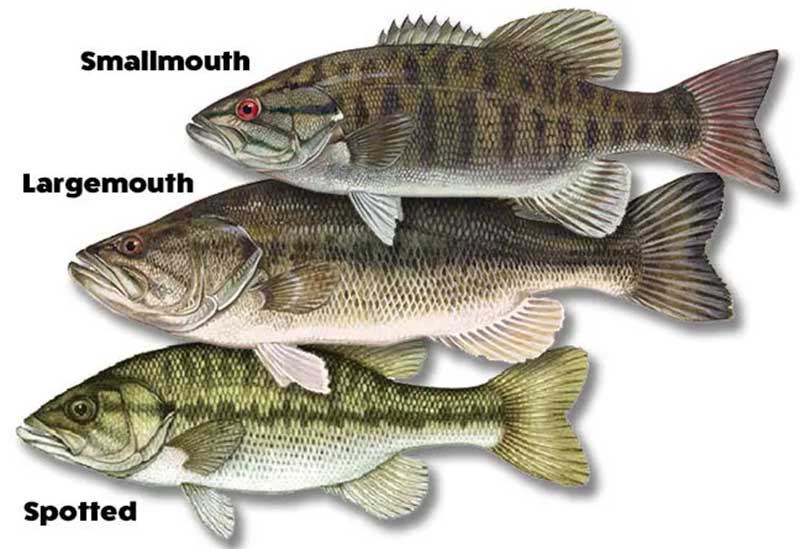Spotted Bass: Identification And How To Catch
Spotted Bass 101: Identification

As you’d expect for a fish of the genus Micropterus, differences between it and other close relatives like the largemouth and smallmouth bass (Micropterus dolomieu) are going to be subtle.
Unlike the largemouth, the spotted bass will have scales on the base of its second dorsal fin. You’ll also notice that the two dorsal fins are connected, creating a shallow “v.”
Spotted bass also sport a circular patch of teeth on their tongue, something largemouth lack.
And finally, on adults, you’ll find the dark spots below the lateral line that give them their scientific name, as well as their nickname “spotty.” But as you can see in the pics above, those spots aren’t the easiest way to tell a spotted bass from a largemouth.
Some folks will tell you that the upper jaw of a spotted bass won’t reach back to its eye, but that’s not true. Just take a look at the photo above.
Spotted bass identification checklist (vs. largemouth bass)
· Separated first and second dorsal fins
· Scales on the base of the second dorsal fin
· Round patch of teeth on the tongue
Now, the real trouble can come in when you need to tell a spotted bass apart from a smallmouth, especially since these two species are known to hybridize, blurring the distinction between the species almost entirely.
Smallies and spotties share that connection between the first and second dorsal fin, and they both sport a rough patch of “teeth” on their tongues.As long as you’re not dealing with a hybrid, the easiest way to tell the difference is that smallmouth lack a distinctively dark coloration over their lateral line, being more or less uniformly gold-green.
Spotted bass identification checklist (vs. smallmouth bass)
· Dark pattern along the lateral line
Close Kin: Micropterus punctulatus and Micropterus henshalli
In 1940, a subspecies of spotted bass was identified by biologists. Called the Alabama bass, it’s native to the Mobile River basin but has since been introduced into the Chattahoochee River (as has the spotty).
As experts from Auburn University explain, “Micropterus henshalli differs from M. punctulatus, with which it has been aligned, by having higher scales counts, a narrower head, smaller-scale width, higher gill raker count, and a smaller tooth patch. It also has a narrower and more elongate body shape than does M. punctulatus.”
In practice, unless you do an accurate scale count along the lateral line, these two species are very, very hard to distinguish.
Spotted Bass Range and Location
Spotted bass can be found as far north as Ohio and Kentucky and make their home along the Gulf states: Texas, Louisiana, Mississippi, Alabama, and Florida. You’ll also find them in Georgia, North and South Carolina, Virginia, Oklahoma, and Arkansas.
While it’s not scientifically accurate to say that the spotted bass is a combination of large- and smallmouth bass, in terms of habitat, it fills a niche that resembles both. Spotties prefer moving water to still ponds, like a smallmouth, but they also like stained and murky water, like a largemouth.
As Kentucky’s Department of Fish & Wildlife Resources says, the spotted bass “occupies primarily streams and rivers, but also occurs in lake (e.g., oxbows) and reservoir habitats. It is less numerous in reservoirs than Largemouth Bass and far less common than Smallmouth Bass in cool, clear upland streams. As with other black basses, Spotted Bass tend to associate with cover in the form of logs, stumps, and other submerged structures.”
As you’d expect of any bass, they thrive in areas with plenty of aquatic vegetation. Like all bass, they feed on insects, aquatic invertebrates like crawfish and other fish, and areas that offer plentiful prey habitat are likely to hold plenty of spotted bass.
